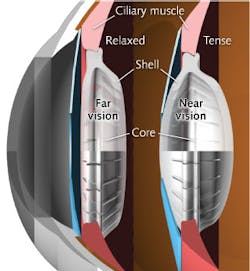Ophthalmology Advances: Bio-inspired intraocular lens mimics natural, adjustable vision
A new intraocular lens (IOL) developed by biolnic (Cologne, Germany) does what standard eyeglasses, contact lenses, and intraocular lenses (with fixed focal lengths) cannot do: its bio-inspired elastic design changes shape and consequently alters refractive power and focus much like a natural eye. Such an “accommodable” IOL is a decisive breakthrough in ophthalmology and the scientists hope to commercialize the lens (with trade name DeepSight) for release in 2019. biolnic says its plan is to market DeepSight with a global-scale player that shares their vision.
Mimicking natural vision
Anatomically, the flexible lens of the human eye is embedded in a “capsular sac” that is attached by laterally radiating zonula fibers to the ring-shaped ciliary muscle. Physiologically, in accommodable vision, the ciliary muscle contracts and the zonula fibers relax, maintaining the natural spherical shape of the lens and enabling near vision. For far vision, however, the ciliary muscle relaxes, the zonula tighten, the capsular sac is stretched over its equator in a radial direction, and the axial compression on the lens deforms it into an elliptical shape with an approximate 0.6-mm-diameter change.
As we age, the lens loses flexibility in a condition called presbyopia; unfortunately, conventional IOLs provide only fixed-focus near or far vision. Using computer simulations that model the anatomical shape and physiological function of the human eye, the biolnic IOL can deliver the 3 Diopter range that allows both near and far vision for its wearer.
The DeepSight lens consists of a high-refractive-index polymer shell and a liquid core; it is inserted in the eye behind the capsular sac and fully enclosed by the ciliary muscle. Thin slits in the lens respond to muscle contractions and the corresponding deformations adjust the lens thickness in a range as high as 30 Diopters. In fact, the wearer can focus the lens from a flat far-vision state to a nearly spherical near-vision state for focusing to a distance as close as 25 cm.
COTECH manufacturing
DeepSight consists of pharmaceutical-grade, thermoplastic-processable, injection-molded half shells that are joined together to form the IOL. The microproduction technologies are based upon findings from the 2008–2012-European-Union supported, 25-member Converging Technologies for Microsystems Manufacturing (COTECH) project (http://www.fp7-cotech.eu).
The complexity of the DeepSight IOL is simplified through an adiabatic injection-molding process with homogeneous pressure and temperature distribution and a minimum melt cushion that avoids any kind of cold material slug. The new hybrid process combines advantages of microinjection molding and hot embossing; clinical trials will be required to establish DeepSight’s safety in ophthalmic applications.
“DeepSight set out to develop a first-in-class biocompatible IOL device that can be very effective in terms of treating presbyopia and cataracts,” says Josef Jansen, founder of biolnic. “The biolnic IOL maximizes the integration of the brilliantly natural and simple design, with advanced polymers and innovative microinjection nanotechnology molding processes.”
“While the medical procedure is similar to conventional IOLs, which can be performed in as little as 10 minutes, regaining full spectrum sight with DeepSight can open many doors for millions of people globally, and the benefits will range from enriching the user’s health and well-being to improving societies’ productivity and economics,” says Andreas Schoth, physicist, engineer, university senior lecturer at the University of Freiburg (Germany), and biolnic development team member.
About the Author

Gail Overton
Senior Editor (2004-2020)
Gail has more than 30 years of engineering, marketing, product management, and editorial experience in the photonics and optical communications industry. Before joining the staff at Laser Focus World in 2004, she held many product management and product marketing roles in the fiber-optics industry, most notably at Hughes (El Segundo, CA), GTE Labs (Waltham, MA), Corning (Corning, NY), Photon Kinetics (Beaverton, OR), and Newport Corporation (Irvine, CA). During her marketing career, Gail published articles in WDM Solutions and Sensors magazine and traveled internationally to conduct product and sales training. Gail received her BS degree in physics, with an emphasis in optics, from San Diego State University in San Diego, CA in May 1986.
